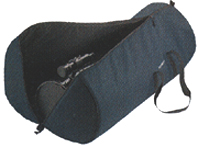Orion Introduction
Orion Accessories
![]() News
News ![]() Products
Products ![]() Pricing
Pricing ![]() Distribution
Distribution ![]() Notes
Notes
![]()
![]()
![]() Mounts
Mounts
![]() Telescopes
Telescopes
![]()
Orion Vixen 102 FL Fluorite Apochromat Refractor
Discontinued, posted as a public service - for information only
The first high performance 4" Apochromatic refractor that amateur astronomers aspired to obtain.
Right: 102FL - 4 Inch f9 Apochromatic Refractor Telescope shown on optional Vixen GP German Equatorial Mount and Tripod (13,789 bytes).

Exquisite! Awesome! Such words are no strangers to owners of the Vixen 102FL refractors. The 102FL is among the most expensive and difficult telescopes to produce - the Apochromat refractor. These apochromatic telescopes were introduced in the early 1980's in order to provide the finest optical imaging performance for the serious amateur astronomer. While the same lens was sold at higher cost in a heavier optical tube marketed by another company, the 102FL has been distributed through the years by Vixen of Japan. Comparison reviews of 4 inch Apos by amateurs and publications consistently rated the 102FL in first place, or among the top two or three. And although the 1990's produced faster refractors (such as those f5 to f6 models we offer by Astro-Physics and by TeleVue), few people will be able to see any difference in the quality of view at similar magnifications between the 102 Fluorite Apo and other first rate refractors. And most people will appreciate the relatively light weight construction, affordability, and ready availability of the 102FL. The 102FL is versatile as not only as a wonderful first telescope, but as a second quick and easy to use telescope, or finder/guide telescope on a larger telescope.
Pure Calcium Fluorite The air spaced doublet objective lens of the 102FL is designed to provide precise optical color correction. The 102FL's objective incorporates a crown element made of pure Calcium Fluorite grown under laboratory conditions. Colors of the spectrum have differing wavelengths, to see this consider how in a normal optical glass prism the red and blue rays are bent at slightly different angles as they pass through. This dispersion results in color fringing manifested usually as a slight violet halo around objects that contrast one against the other, and an overall lack of sharpness. In camera normal and wide-angle lenses this is imperceptible or can be corrected with other techniques, but telescopic lenses magnify the variation in focus between red and blue light rays. Camera lens making companies (Carl Zeiss, Nikon, and Canon) were among those who pioneered the Extra-Low Dispersion glasses, and the Fluorite crystal technologies to solve this problem. This crystal material provides reduced chromatic aberration in portions of the spectrum from the D (yellow), through C (red), F ( blue) and G (purple) Fraunhofer lines. The transmitted wavelength from 0.125 to 10 microns is twice that of BK-7 - Borosilicate Crown glass.
Also this lens design permits the construction of a more compact and improved alternative to traditional Achromatic f11-f15 refracting telescope designs. It makes possible performance that is better than conventional Crown glass and ED Fluorocrown glass alternatives; and in fact the 102FL can only be rivaled or bested by a few Apos which incorporate a triplet Fluorite lens, or the latest generation SD Fluorocrown glasses. Very few companies in the world have been able to consistently manufacture high performance Calcium Fluorite lenses, but a subsidiary of Canon has proven this technology for use by Vixen and by other reputable Apo makers. A controlled optical bench star test will show zone free symmetrical diffraction patterns in and out of focus, with crisp hard diffraction rings.
Who is Vixen? Vixen is the company who manufactures the optical tube, GP and GP-DX mount, and many accessories. In the U.S.A. their products are usually distributed through third parties. Vixen was founded as a wholesale distributor of optical goods in Japan in October 1949 by the present Chairman, Mr. Kosuke Tuchida. The automated manufacturing of the optical tube mechanical components and of the optional Vixen Great Polaris mount by Vixen Development and Manufacturing Co., Ltd. allow this telescope and suitable mounts to be priced most attractively. As when introduced, the 102FL remains a best value 4" Apochromatic refractor. Vixen made Fluorite Apos were for a time available in 70mm, 80mm, 90mm and 102mm but now only the 80mm and 102mm models remain in production. In all of our years of selling the Vixen Apos (for a time distributed by Celestron), Company Seven has never experienced any instance of less than praise from the owners of these lenses. Anyone who demands better performance or versatility will have to be able to pay the extra $1,000 or more to obtain it.
Incidentally Vixen was named after a reindeer in Clement Clark Moore's famous 1822 ballad: "Now, Dasher! now, Dancer! now, Prancer!, and Vixen! On, Comet! on, Cupid! on, Donner and Blitzen!"
What does it do? The Apochromatic refractor has been the traditional top choice of visual astronomers. The combination of thermal stability, best view per pound of telescope, clear high contrast images, and apparent brightness can surpass more expensive designs such as the 8" Schmidt-Cassegrain telescope.
A real, and relatively affordable "Mars" scope...
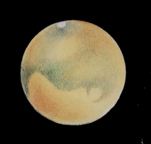 Left: Mars as observed by Robert Kochenour through 102FL with TeleVue 9 Nagler ocular and 2X Barlow (200X), 20 Sept. 1988 (3:45 U.T. 21 Sept.). Seeing conditions 7-8. Copy of pencil and pastel sketch. Mr. Kochenour is a Vixen 102FL and Astro-Physics 155mm EDT customer, and friend of Company Seven (11,417 bytes).
Left: Mars as observed by Robert Kochenour through 102FL with TeleVue 9 Nagler ocular and 2X Barlow (200X), 20 Sept. 1988 (3:45 U.T. 21 Sept.). Seeing conditions 7-8. Copy of pencil and pastel sketch. Mr. Kochenour is a Vixen 102FL and Astro-Physics 155mm EDT customer, and friend of Company Seven (11,417 bytes).
The degree of lens perfection in the 102FL is so good that there is barely any perceptible false color even when observing at high magnifications on the brightest stars such as Vega. False color is not likely to be seen on the Moon, or planets including a very bright Venus! And the lens is very well corrected for spherical aberration providing views of . This telescope provides stunning lunar and planetary observing; it can clearly reveal changing features on several planets through out observing seasons. You may imagine you are seeing details on the moon as if you were in orbit - even though the smallest object you could see with this telescope will actually be about 4 kilometers in diameter! Star clusters may appear three dimensional, with stars floating as intense diamonds against a black velour background. Those who like to play "telescope testing" are likely to be pleasantly surprised at the Airy disk and diffraction ring patterns appearing distinct and nearly symmetrical in and out of focus, with no signs of zones or roughness - tell tale signs of patient and professional lens making.
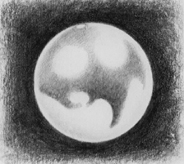 Left: Mars as observed by Robert Kochenour through 102FL with TeleVue 7mm Nagler ocular and 2X Barlow (258X), 26 Sept. 1988 10:00PM E.D.T. Seeing 8-9. Copy of pencil and pastel sketch. (21,012 bytes).
Left: Mars as observed by Robert Kochenour through 102FL with TeleVue 7mm Nagler ocular and 2X Barlow (258X), 26 Sept. 1988 10:00PM E.D.T. Seeing 8-9. Copy of pencil and pastel sketch. (21,012 bytes).
Aside from brilliant performance at higher magnifications, the telescope is quite at home sweeping the Milky Way, or Comet hunting. This is an easily manageable telescope with the unobstructed 101.9mm light gathering power and fields of view to recognize many of the popular deep sky objects. Tease subtle details out of coy deep-sky denizens: Galaxies, Star Clusters, Nebulae, Planetary Nebulae, etc.. Try a TeleVue 55mm Plossl on for size at 16x providing a true field of 2.92 degrees. Or take the plunge into awesome perfection to the TeleVue 31mm Nagler Type 5 at 43x showing 2.64 degrees - more area than the 35mm Panoptic with a view akin to looking out of a port hole! The combination of field of view and light gathering power will make hunting the large deep sky objects very rewarding, even more so with optional light pollution rejection filters.
For examples of how the faint, deep sky objects may appear in a good 4" refractor we suggest you look at the book Deep-Sky Companions: The Messier Objects where the author Stephen O'Meara sought to keep the drawings relevant to the amateur. To produce the highly detailed drawings of these celestial objects Stephen chose to observe with the second generation TeleVue "Genesis" telescope (4" aperture Achromat, 500mm f5) which has since been replaced by the improved TeleVue apochromatic telescopes. This book has become one of our best advertisements for the versatile, readily transportable fast 4 inch (10cm) refracting telescopes.
The relatively short focal length of the 102FL is made even shorter still with the optional focal reducer, delivering wide-field views and give the 102FL exceptional capabilities for astrophotography too.
Features of the Orion Vixen 102 FL Fluorite Apochromat Refractor:
- Lightweight, yet precise mechanical construction of metal and aluminum.
- 2" diameter rack and pinion focuser. Moves with smoothness and precision, with no hint of backlash or play.
However, with our optional 2" Visual Accessory Back focuser can accommodate optional 2" diagonal and eyepieces, camera adapters, and more - Focuser draw tube includes reducer to accept furnished 1.25" (31.7mm) accessories
- Focuser tension adjusting/locking screw permits the user to secure focus with heavy loads attached (such as a film or CCD camera) so that focus will not accidentally change over the course of an exposure or viewing session
- Adjustable Objective Cell: Push-Pull design
- Optics very smoothly hand finished
- Clamping Tube Mounting Rings allow easy installation or balancing of OTA
- Achromatic 6x 30 Finder, 8 Degree Field of View
- Quick Release Bracket for Finder
- Dew Shield - thread on and easily removed, 6-7/16" (163mm) long
- Lens Cover with 45mm Solar Aperture Stop
- Illustrated instruction manual
- Five year Limited Warranty
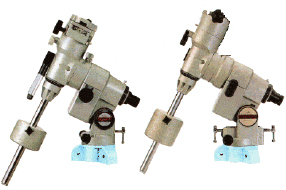 Right: Vixen GP (at left) and DX (at right) German Mount Heads. Furnished aluminum tripods are not illustrated. (42,675 bytes).
Right: Vixen GP (at left) and DX (at right) German Mount Heads. Furnished aluminum tripods are not illustrated. (42,675 bytes).
Ordering the telescope with either the Vixen GP or GP-DX Equatorial Mounts adds:
- Vixen GP (15 lb / 7 kg. payload rating) or GP-DX (22 lb / 10 kg. payload) Mount Head
- Weight of telescope with GP German Mount is only 46 lbs. (20.9 kg)!
- Weight of telescope with GP-DX German Mount is 56.5 lbs. (25.7 kg)!
- Quick Release Plate to facilitate setup or take down, or change of instruments
- Right Ascension and Declination have 144 tooth Worm Gear Sets
- Right Ascension Fine Geared Manual Slow Motion Controls
- Declination Fine Geared Manual Slow Motion Controls
- Right Ascension Setting Circle - 10 Minute increments
- Declination Setting Circle - 2 Degree increments
- Adjustable Height Aluminum Field Tripod (70cm to 110mm long)
- Illuminated 6x 20mm Pole Alignment Finder - 3 minute accuracy possible
- Head Elevation and Azimuth Fine Adjustment Controls
- Latitude Adjustment Range: from 0 to 62 Degrees
- Easy tracking manually at up to the limit of the telescope.
- 8.14lb./3.7 kg Counterweight
- Ability to accept optional Single or Dual Axis Drive with Controller for effortless tracking, or astrophotography
 Receive a FREE TheSky SE™ Astronomy CD-ROM with purchase of any Orion-brand astronomical telescope.
Receive a FREE TheSky SE™ Astronomy CD-ROM with purchase of any Orion-brand astronomical telescope.
It is your personal planetarium and guide to the night sky. An $89 value!
TELESCOPE SPECIFICATIONS:
| Specification | |
|---|---|
| Clear aperture: | 101.9mm (4") |
| Focal length: | 902mm (35.5") |
| Resolution (visual): | 1.14 arc seconds |
| Resolution (photo): | 0.73 arc seconds |
| Coatings: | Multi-layer on Flint |
| Light Gathering Power: | about 190X that of unaided eye |
| Visual Magnitude Limit: | About 12.3 |
| Magnification range: | 16x to 400x |
| Tube assembly construction: | Painted finish, aluminum tube; fully baffled, collimate able Push-Pull cell construction |
| Tube assembly length: | 38.2 Inches (970mm) |
| Tube assembly diameter: | 4.53 Inches (115mm) |
| Focuser type: | 2 inch rack and pinion |
| Focuser Travel: | 3.125 inches |
| Telescope length with 1.25" diagonal: | 100.3cm (39.5") with dew cap |
| Weight with diagonal: | 7.9 lbs. (3.6 kg) |
| 35mm prime-focus field: | 2.22 x 1.5 x 2.7 degrees @ f8.9 |
| 35mm field with Focal Reducer: | 3.59 x 2.46 x 4.39 degrees (vignetted) @ f5.5 |
| 35mm field with 2x Barlow: | 1.1 x 0.8 x 1.4 degrees @ f17.4 |
* Specifications are subject to change without notice.
SUGGESTED ACCESSORIES
These are optional accessories that are not included with the telescopes that we highly recommend for your viewing pleasure and long term success:
- Equatorial Mount: a good quality equatorial mount will improve the usability of this telescope, and permit it to attain its high magnification potential. A telescope of this high quality deserves a good quality, rigid platform to support it. We recommend you consider either:
- Vixen GP Mount. Supporting the 102FL tube assembly (illustrated at top right of this page) is the time-honored Great Polaris equatorial mount. Its precisely cast aluminum construction provides rigid stability, yet its slow motion hand driven controls move the telescope with velvety smoothness in each of both axes. Its folding aluminum tripod provides solid support, yet is remarkably lightweight and portable. This is the least expensive mount that can manage this telescope well. For those who observe from wind prone locations, or who intend to become involved in astrophotography, then we suggest you consider one of the following mounts:
- Vixen GP-DX Mount. Very similar to the GP mount but with even better rigidity to support the telescope in sites exposed to light winds.
- Losmandy Hollywood General Machining Model GM-8 mount. A good choice of high precision tracking platform.
- Losmandy Hollywood General Machining Model G-11 mount. Excellent choice for astrophotography with reserve for growth to larger telescopes.
- Astro-Physics Model 400GTO mount. Excellent choice for astrophotography with "Go-To" computer control automation.
- Vixen GP Mount. Supporting the 102FL tube assembly (illustrated at top right of this page) is the time-honored Great Polaris equatorial mount. Its precisely cast aluminum construction provides rigid stability, yet its slow motion hand driven controls move the telescope with velvety smoothness in each of both axes. Its folding aluminum tripod provides solid support, yet is remarkably lightweight and portable. This is the least expensive mount that can manage this telescope well. For those who observe from wind prone locations, or who intend to become involved in astrophotography, then we suggest you consider one of the following mounts:
- Eyepieces: Orion includes two eyepiece with this telescope, 9mm and
25mm Plossls. Typically astronomers will wish to initially set up the telescope
with at least two or three 1.25" or 2" eyepieces to address:
- Low magnification: for views of the faint deep sky objects a 32mm to 35mm
focal length eyepiece.
- Middle Magnification eyepiece - usually between 80 to 120X, for views
of the full Moon, Star Clusters, etc.
- High magnification: 200X or more for views of the planets
Simpler eyepiece designs such as the Plossl, Orthoscopic will work well on this telescope. If you prefer to see wider fields of view, and if you require long eye relief (distance from lens to the eye) to accommodate spectacles, then Company Seven recommends eyepieces of advanced designs such as those pioneered by Al Nagler, founder of the TeleVue company. TeleVue's advanced designs include the "Nagler", "Radian", or "Panoptic" series eyepieces. These oculars will provide the widest clear, and flat field images bringing out the most in your telescope (and many other) telescopes. For manually driven mounts in particular, wider field of views are also desirable since as the Earth rotates and objects drift across the field of view, a wide angler ocular shows an object for some time longer before having to adjust the telescope.
Please refer to the brochure and the test report/data from Company Seven enclosed with our telescopes for detailed characterizations of many suggested eyepieces:
Eyepiece Magnification Actual field of view Exit pupil 55mm Plossl (2" eyepiece) 16x 2.92 degrees 6.21mm 40mm Plossl 31x 1.23 degrees 8.10mm 35mm Panoptic (2" eyepiece) 36x 1.77 degrees 7.08mm 32mm Plossl 39x 1.23 degrees 6.48mm 17mm Nagler (2" eyepiece) 74x 1.11 degrees 3.44mm 15mm Plossl 84x 0.58 degrees 3.04mm 12mm Radian 105x 0.58 degrees 2.43mm 6mm Radian 209x 0.29 degrees 1.21mm - Low magnification: for views of the faint deep sky objects a 32mm to 35mm
focal length eyepiece.
- Guide book: "Backyard Astronomers Guide" or "Nightwatch" by Terrence Dickinson, or "Starware" by Phil Harrington. For the novice from age 8 to 15 or so up to adult. Good introductions to astronomy, the use of telescopes, and their accessories. Easy introductions to finding ones way around the night sky.
- Red LED Flashlight such as the Rigel Skylite to help one set up and use a telescope, and to read charts or a planishpere without adversely impacting the observers night vision.
- Vixen 2" Visual Back to accept optional 2" diameter Mirror Diagonal, Eyepieces, or Camera Adapter.
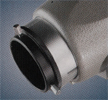 Company Sevens suggest's our customers choose either the TeleVue Standard,
Company Sevens suggest's our customers choose either the TeleVue Standard,
TeleVue "Everbrite", or the Astro-Physics Maxbright 2 inch Mirror Diagonal.
- Camera Adapter: The C-102FL is at its best in astronomical applications, but may be used as a terrestrial telescope, or as a Super-Telephoto lens for video or 35mm film uses.
- Focal Reducer: For visual or photographic use. Shortens the effective focal length of 102FL telescope from 900mm (f8.9) to 550mm (f/5.5). Corrector provides 35mm format Fields of view of up to about 3 degrees!
- Vixen 60mm Astro photographic Guide Telescope with Bracket.
- Telrad illuminated sight: to aid one in finding and centering objects in the main telescope, and learn the sky by "star hopping" from one object to another
- Planisphere: the easiest way to find what is up in the sky at any given time and date, and an aid to planning future sessions.
- Neutral Density and Color Filters to reduce the brightness of the Moon and Planets, and highlight subtle features.
- Sky Light Pollution Rejection Filter to reduce the greenish or golden background glow from city lights and darken the sky background - aid seeing faint Nebulae.
- Orion fitted Carrying Bag (sample shown at right) for safer, and more convenient transport the telescope optical tube assembly. Keep in mind that these are very convenient and lightweight bags, but are not suitable for shipping a telescope.
- Barlow or TeleVue "Powermate" Lens: Company Seven suggests you consider any of a number of 1.25 inch or 2 inch diameter Barlow lenses that we offer to double or more than triple your magnification. Furthermore, these accessories can project an image farther from the focuser to attain focus with most 35mm SLR cameras, optional accessories such as binocular viewers, etc. Contact Company Seven for suggestions on how to to best meet your goals.
- Telescopes such as this often put the eyepiece at position that is only about 3 or 4 feet (0.9 or 1.2 meters) from the ground. Since most of our customers are taller than that, they will find it uncomfortable to stand bent over to observe for extended periods. For a much more enjoyable and comfortable observing experience, Company Seven recommends the Observing Chair; this is our most comfortable, flat folding, adjustable height seat. It is not inexpensive, but is so practical and can be used for camping or other times when a comfortable portable seat is desired.
